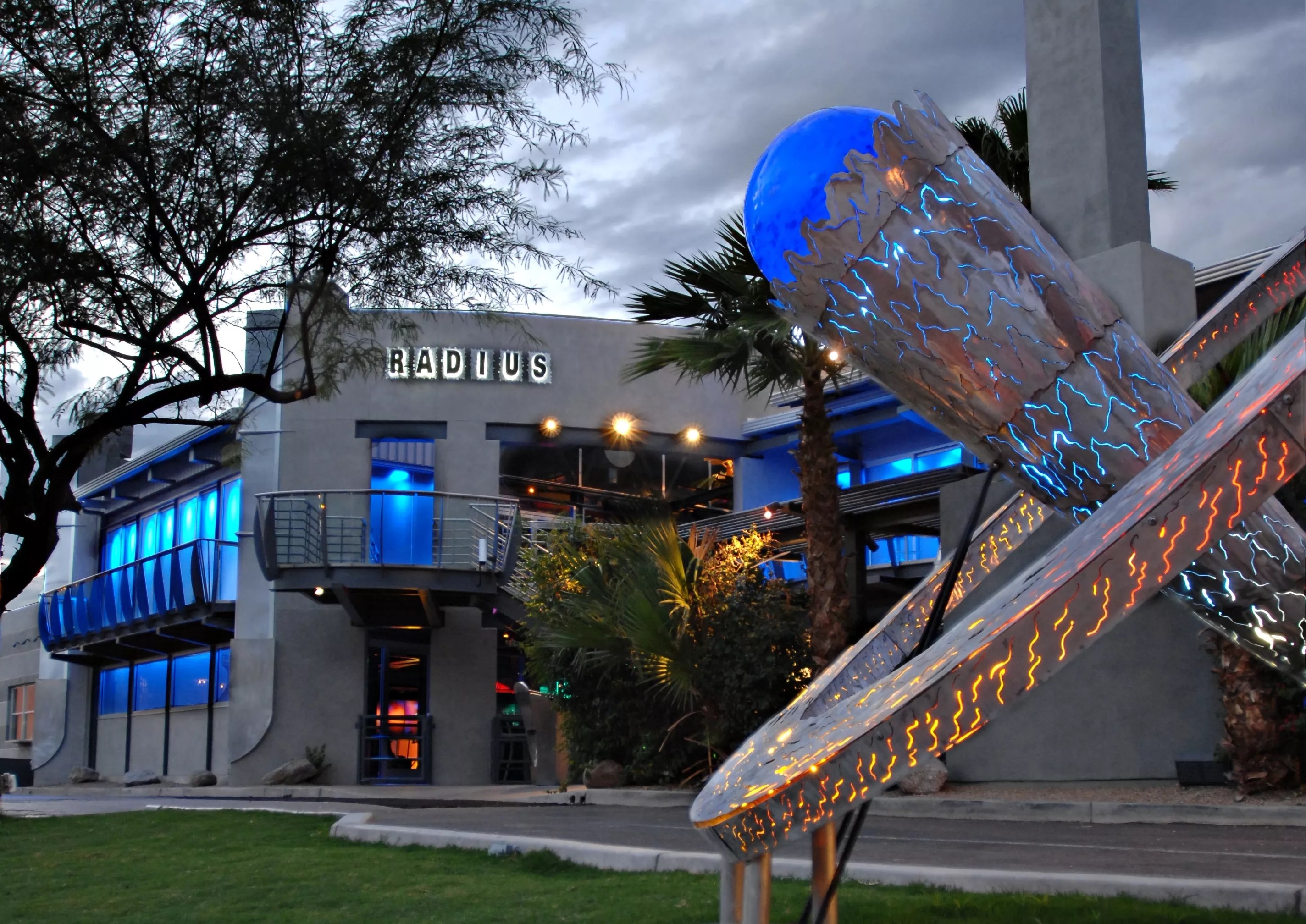
Evening Entertainment Group

Audio By Carbonatix
In Scottsdale’s Entertainment District, nothing lasts forever. Bars and nightclubs tend to fizzle out after only a few years in operation as crowds typically move on to something new.
Then there was Axis-Radius, the iconic Scottsdale nightclub that thrived for 16 years, far longer than most other spots.
The double-sided nightclub, co-owned by Valley restaurateurs and nightlife impresarios Les and Diane Corieri, was a party playground and dance destination for countless clubgoers, serving as one of the more influential and landmark spots in Scottsdale.
After opening as a cigar and martini joint in 1997, Axis, and later its neighboring dance club Radius, were havens for all manner of drinking and dancing by the bottle-popping crowd, while also playing host to more than a few celebrities and professional athletes.
It also hosted gigs by hundreds of DJs and EDM artists, both locally and nationally known.
Axis-Radius not only helped the Corieris launch their ever-growing empire of local bars, restaurants and nightlife establishments (which now include such spots as Hi Fi Kitchen & Cocktails, Bottled Blonde, Bevy and Casa Amigos) it paved the way for Scottsdale’s Entertainment District.
Axis-Radius eventually closed in 2013, but the club is still remembered for its influence and impact on the Scottsdale nightlife. Phoenix New Times spoke with Les Corieri and others who were involved with Axis-Radius over the years for a deep dive into the club’s history.
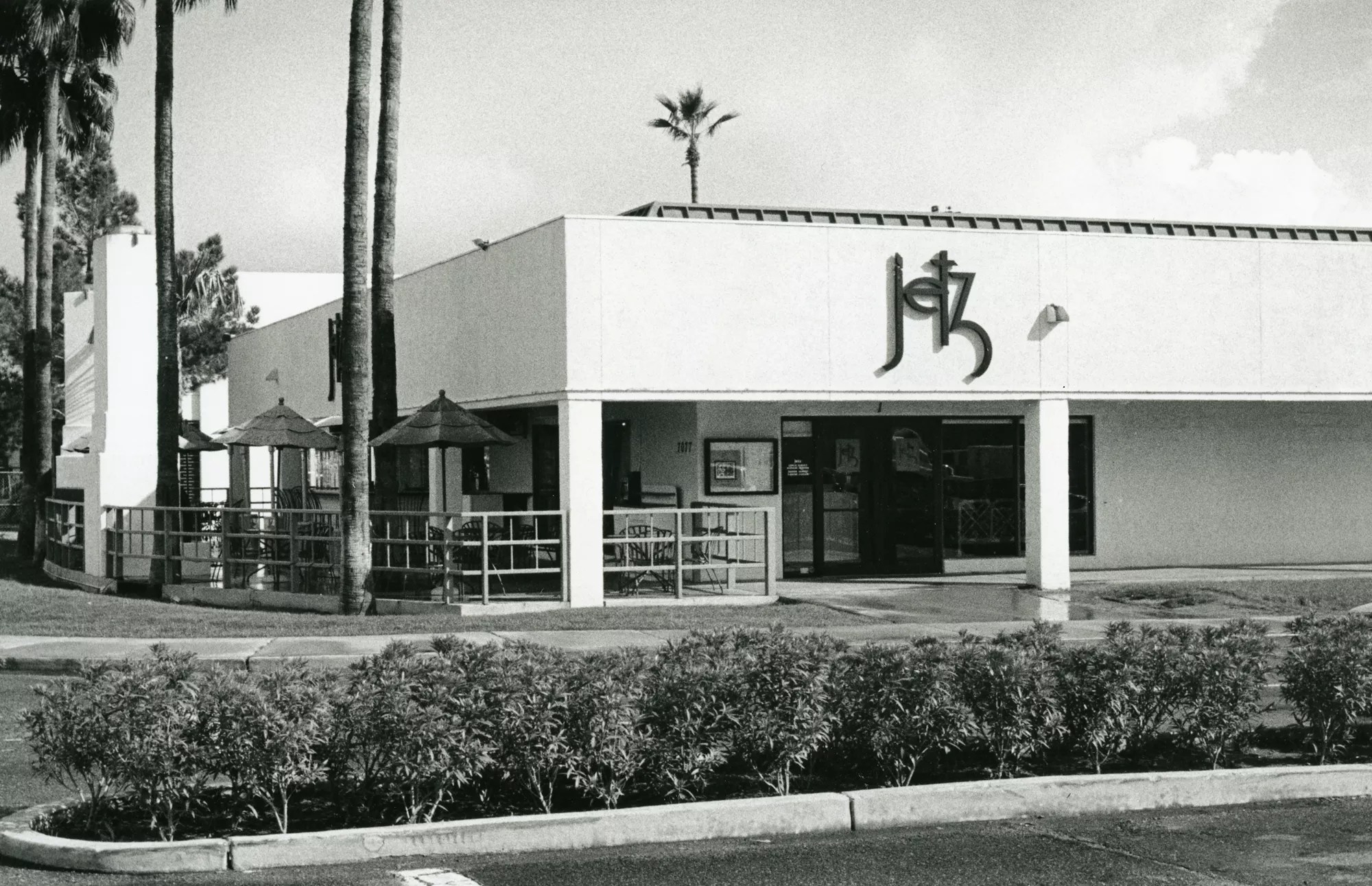
An undated photo of now-demolished Scottsdale restaurant and bar Jetz.
Scottsdale Historical Society/Scottsdale Public Library
The days of Jetz and Stixx
Les Corieri started in Valley nightlife in 1985 after purchasing Tempe spot Clancey’s and transforming it into a nightclub called Surprizes. He didn’t stop there. Over the next several years, Corieri and his wife, Diane, became involved with now-defunct Scottsdale nightclubs Trocadero’s and Ten Downing Street. By 1993, the couple co-owned Jetz, a restaurant and bar, alongside a neighboring pool hall and nightspot called Stixx, both located at the now-demolished Camelback Mall.
Les Corieri, co-owner of Axis-Radius and Evening Entertainment Group: Jetz was open for lunch, but it was more of a high-energy restaurant and bar. Stixx was more of a nightclub with really nice pool tables, so it played different (roles).
Mark Drinkwater, co-owner of Axis-Radius, 1997 to 2001: (Les) and I were partners in those days. We co-owned Ten Downing Street and also had Jetz and Stixx. That’s what really kicked Les and I off. Jetz and Stixx became famous. It was just a “who’s who” place where (Michael) Jordan and (Charles) Barkley were at all the time and all the Suns were there in ’93. It was amazing. And those places are really what took us to that next level.
DJ Z-Trip, former Phoenix resident: Jetz and Stixx, at the time, were two of the hottest clubs in Arizona. I remember Barkley and Tiger Woods coming in and they’d bring everybody. All the bottle service stuff was brewing at the time. And they’d come to the clubs and we’d play music for them.
Aaron Scofield, DJ and former club promoter: I worked at Jetz and Stixx on Thursdays and Saturdays and (Z-Trip) was there on Fridays. And the DJ booth was right next to where they had their VIP area, which was just a bunch of rope around a pool table and all of the people from the Suns, with the Cardinals, would always be there. People were just lined up along the walls. It was absolutely fascinating, but it was a fun time.
Despite the popularity of Jetz and Stixx, the bars were on borrowed time. In the mid-’90s, local developers set their sights on Camelback Mall as a potential component of the multimillion-dollar Scottsdale Waterfront project, which would create high-end retail and living spaces south of Camelback Road along the Arizona Canal. Corieri and Drinkwater engaged in legal battles with developers and began looking for somewhere nearby to open a bar. They settled on property on Indian Plaza just west of Saddlebag Trail.
Corieri: Jetz and Stixx ended up getting (pushed out) for the Scottsdale Waterfront. So we were forced to leave that location. We bought the land in 1996 where Axis and Radius would sit to relocate our businesses there.
Drinkwater: I think we paid something like $300,000 for it. And I remember he and I were scared we’re gonna go broke. There was nothing over there back then.
Corieri: Most of the buildings were boarded up and there were a few businesses in what we call “The U” today. There was a lot of vacancies, a lot of boarded-up buildings, but it was far from being an entertainment district. When we actually bought the property with the idea of opening a bar, people thought we were crazy.
Steve LeVine, local concert and event promoter: It was just a bunch of office buildings, maybe a couple of restaurants, the Swedish consulate and a few other things.
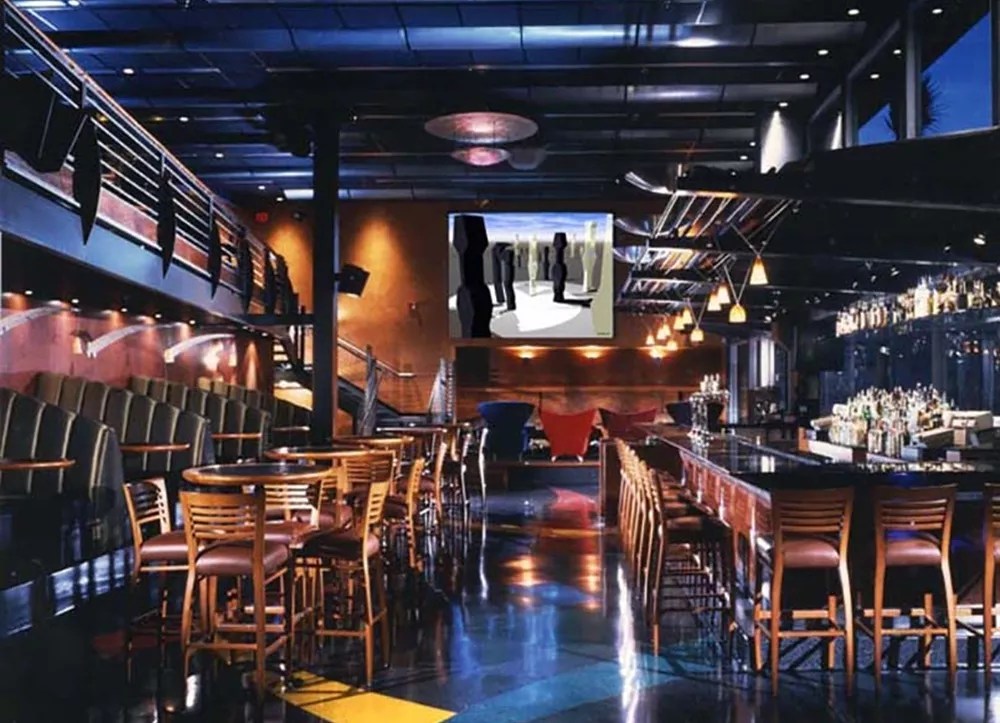
The original interior of Axis in 1997.
Marilyn Szabo
The birth of Axis
Corieri and Drinkwater began developing Axis in early 1997, envisioning the project as an upscale cigar and martini bar.
Drinkwater: We developed Axis first. We wanted to do a cigar bar because those were really popular for a couple years there (in the ’90s).
Corieri: It would be a loungey environment and also a smoker’s lounge.
Jeff Zischke, local artist and designer: I got the gig designing Axis gig through Les and Mark. I’d done lighting for them at Stixx and Jetz. And I got to be known as a guy who did custom lighting. I fell into that because I’m also an artist, designer and sculptor. So they gave me the gig.
Drinkwater: (Axis) was a collaboration where Les and I and everyone involved all worked on it together. Les’ wife, Diane, was involved, too. Diane was fantastic with that part. She’s very creative.
Zischke: They gave me free reign. I designed the floor, the booths, furniture, furnishings, lighting, their logo, the cigar bar, all the cubbies and incorporated some great materials. Mahogany that’s roll-printed stainless. Terrazzo flooring. I always tried to seek out the coolest stuff.
Corieri: It was in a very warm and inviting atmosphere. A lot of woods, black granite and oversized booths. We wanted a very comfortable feeling, that you’d want to come in, lounge around, have appetizers, share food and smoke a cigar.
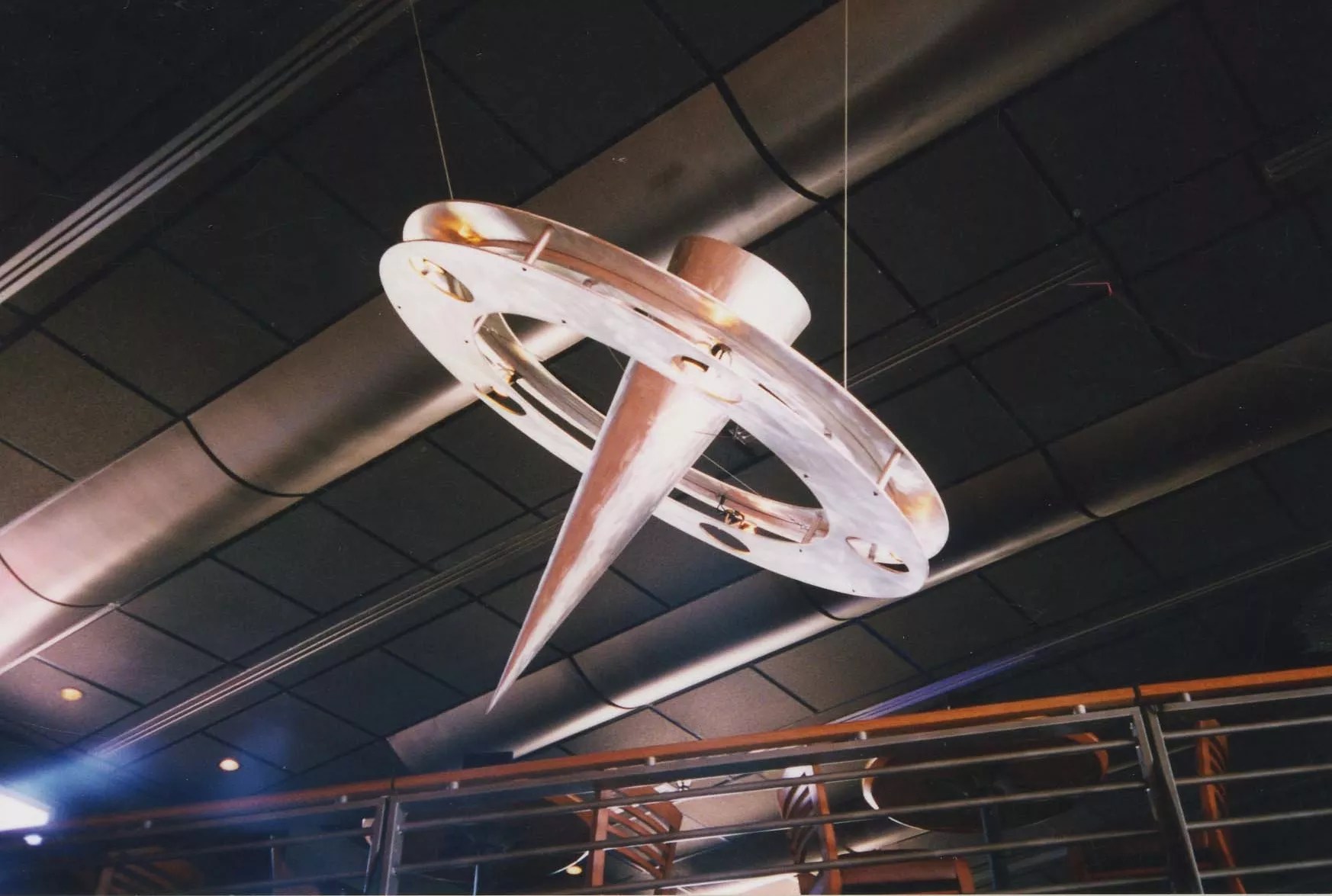
A chandelier created by local artist Jeff Zischke in the shape of the Axis logo.
Jeff Zischke
Axis debuted in August 1997. Corieri says the spot got a good response, albeit limited to the early evening.
Drinkwater: Before (Axis) opened, Les and I and Diane were scared. We had our balls on the line, I’m not going to lie. But people loved it.
Jeff O’Neil, operations manager for Evening Entertainment Group (in 2013): It was this nice spot with cigars and martinis where we were open seven days a week with a great kitchen.
Corieri: When Axis opened, it was just a cigar bar. There was no DJ, no dance floor. It was just music that we played over our (sound) system.
Dave Rajput, resident DJ and entertainment director at Axis-Radius, 1997-2000: Les just wanted pre-programmed music at first. He bought this brand new Pioneer 200 CD player. And there was a new computer program where you could load up with 200 CDs and program it out. But playing pre-programmed music at a bar doesn’t work all that great because the mood is always different because people are always different. A live DJ can react to the changing crowds and moods.
Corieri: Axis was doing well, but we knew it could do better. It didn’t have the energy to hold a late-night crowd. When it’s your intention to do a nightlife concept, you want business up until (last call), and it just didn’t have enough energy. It would start dying out at 11 o’clock. That’s why we made the decision to put in a DJ.
Rajput: I remember talking to Les. I said, “Why don’t I just bring some speakers in and I’ll just try DJing on a Friday night and see what happens?” He said, “Okay. Let’s give it a shot. It has to be better than this pre-programmed computer thing.” I did and it was very popular.
Scofield: They were in good hands because Dave was (DJing) had that good sense and ability how to make a (cigar bar) edgy enough to where the music is not too cool for the room, but not too slow either.
Corieri: Once we put in the DJ booth, the change was immediate. The numbers probably at least doubled.
Rajput: As soon as I started playing music, people were dancing all over Axis.
Rob Wegner, resident DJ at Axis-Radius, 1998-2000: I think Dave Rajput had a big role in generating a dance floor energy at Axis. And it gradually grew on weekends and then expanded to weeknights and then Dave brought me on board to DJ with him.
Rajput: After a few weeks of having DJs, Les said, “You know what? We got to try to do something with the property next door. I want to open a dance club because there’s an opportunity for it.” I said, “That’s a great idea.”
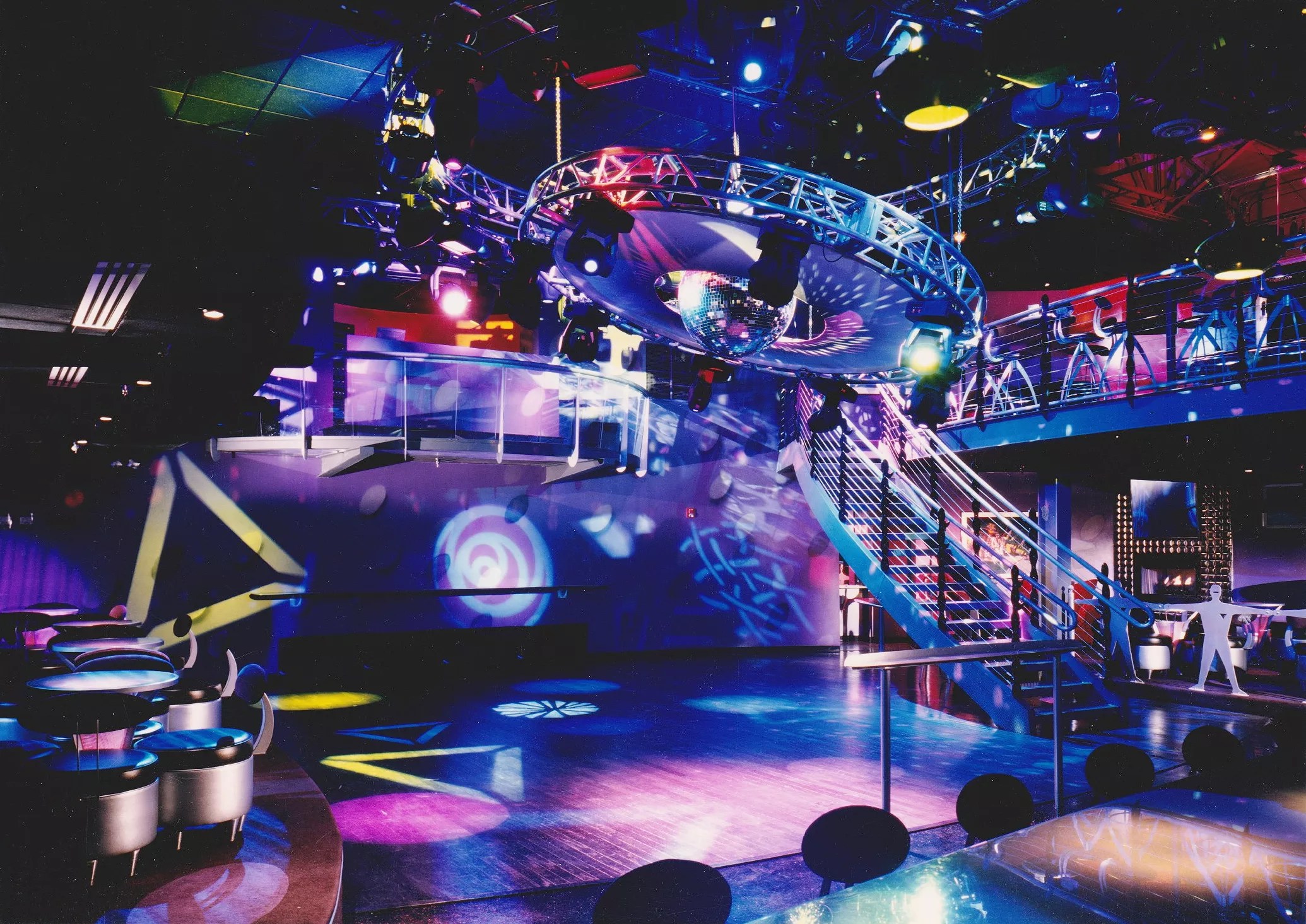
The original design of Radius in 1998.
Marilyn Szabo
The rise of Radius
In June 1998, Axis installed what was described as a “teeny” dance floor. By then, Corieri and Drinkwater were constructing a dance club next door, which would become Radius in November 1998.
Corieri: Axis was a cigar bar converted into a nightclub, but it wasn’t laid out like a (proper) nightclub. So we decided to build the perfect nightclub next door with no food or no restaurant. Just strictly a two-level, high-energy nightclub.
Drinkwater: We created Radius as a full-blown nightclub and nothing else.
Zischke: It was a fun process designing Radius. I made the stools, the tables, the booths. I did the railing for the VIP (section) with figurative elements that resembled a line of people because it was like security guards holding everyone back. It gave it a little bit of an edge. They were just very open to letting me do whatever I wanted.

The VIP and balcony of Radius in 1998.
Marilyn Szabo
Scofield: Les was giving us a tour when they were still laying down the bricks for Radius, and I remember saying, “You’re basically trying to do Jetz and Stixx again.” He was like, “Yeah, just a larger version of it,” like two different vibes.
Corieri: There was some risk with opening a nightclub (next door), because how would it affect the business of Axis? But they were connected, both on the bottom floor with an atrium and also a skywalk between the top two levels, it worked out amazing. If people didn’t like what was happening at Axis they could just go over to Radius.
Wegner: I got to DJ the very first night at Radius, which wasn’t easy. The club was so new there was still construction dust floating around everywhere. I was playing vinyl records and the dust started caking up in the grooves and the needle kept skipping. I had to constantly blow on the records while I was playing.
Rajput: The response to Radius was great after it opened. People started lining up at 8 o’clock each night. We were only open until 1 a.m. back then and the line would be down the street by 8:40 or 8:45.
Local clubgoers weren’t the only ones coming to Axis-Radius. Celebrities like Michael Jordan, Rod Stewart, and George Clooney were reportedly spotted at the clubs.
Wegner: That was insane. I’d been working in the nightclubs since I was 18, but I’d never seen anything like that in my life. There were Ferraris and Mercedes and Mike Tyson’s Rolls Royce parked outside. Radius has this platform in front of the original DJ booth where people would dance. And when I was DJing one night, I looked over and saw Ashley Judd had gotten up there to dance.
LeVine: It’s pretty cool when you’re seeing just celebrities in your place. I remember seeing Charles Barkley and Steve Young. And when that happens, you’re like, “I want to be here. I want to be at the same place that those guys party.” It’s part of the attraction.
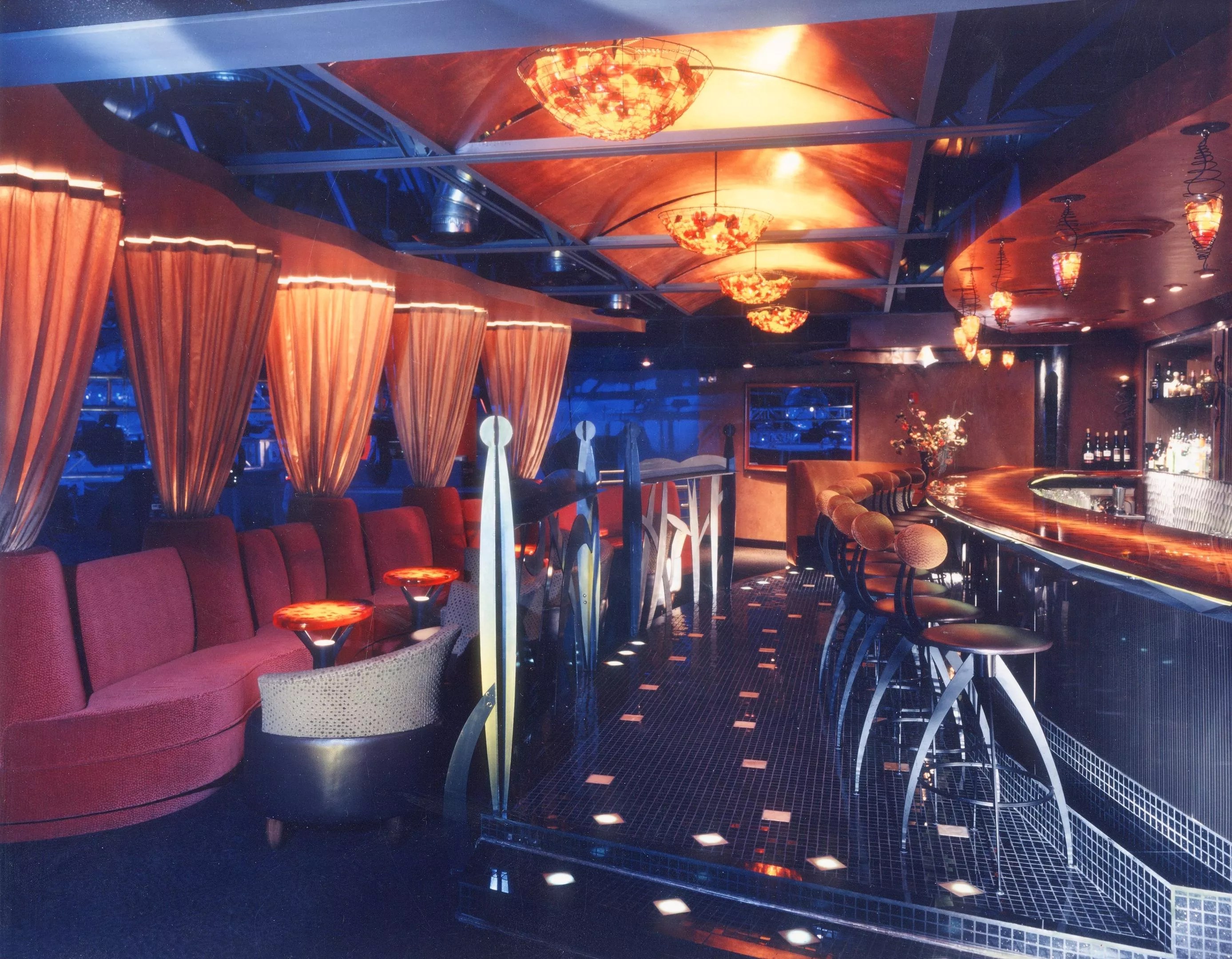
The Amber Lounge on the second level of Radius in 1999.
Marilyn Szabo
In 1999, Corieri and Drinkwater added a VIP area called the Amber Lounge on the second level of Radius as part of a half-million-dollar renovation.
Rajput: Back then, clubs had a short life. Things never lasted that long, maybe a few years. But we stayed on top of things and Les did a nice remodel (and) put in the Amber Room. Before that, the second floor of Radius was just a waiting area for people to come downstairs.
Zischke: The Amber Room was spectacular. It had curtains to make it a separate area and all this mohair fabric. There was a 40-foot bar in there that was made out of resin by (Arizona jewelry designer) Russ Twiford. We had to bring it in on a flatbed truck. It took like 20 guys to move it.
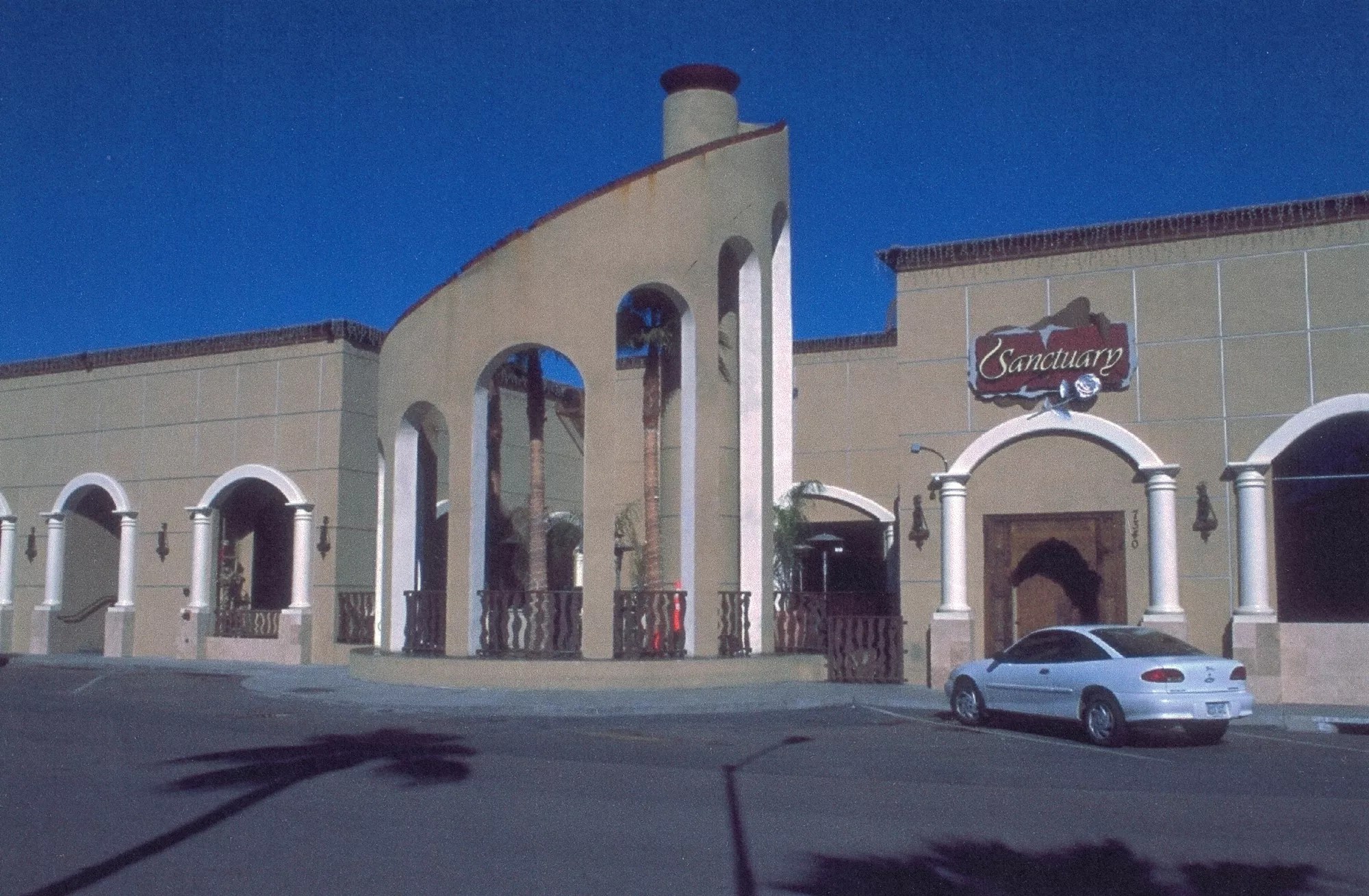
An undated photo of now-demolished Scottsdale nightclub Sanctuary.
Scottsdale Historical Society/Scottsdale Public Library
More clubs, more competition
By 1999, Axis-Radius wasn’t the only night spot in the area. That same year, local entrepreneur and developer Shawn Yari opened the equally extravagant dance club Sanctuary nearby. Two years later, Corieri and his partners opened Suede Restaurant and Lounge across the street from Axis-Radius.
Rajput: Within a year of Radius debuting, Sanctuary had opened. And it brought more people to the area. And that part of Scottsdale just started to develop as a cool place to go.
Corieri: There’s no question. Axis-Radius ignited that entire area. SIX (Lounge) opened after us. Sanctuary opened after us. Axis and Radius was the motivation for the other places to open in that area, without question. They opened before Suede, which was our ultra lounge.
Rajput: One of the partners said, “Hey, I’d like to open a little lounge across the street,” which became Suede. I was like, “That’s a good idea.” And then boom, [nightlife] just started building up from there in that neighborhood. And the (city of Scottsdale) eventually relaxed things a little bit. They used to be harder to deal with before then, as far as opening clubs, but they began changing their minds.
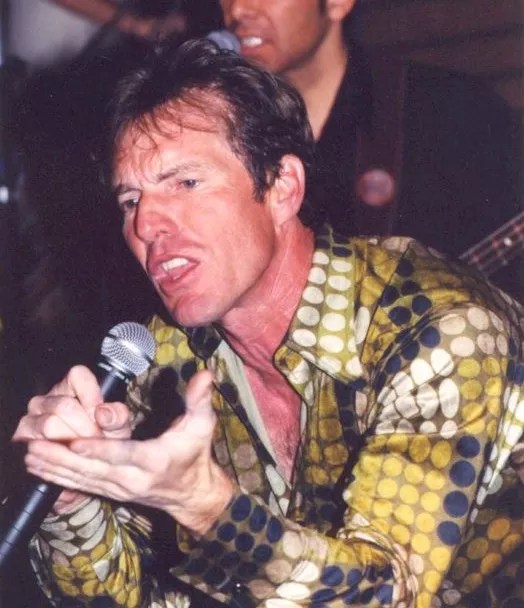
Actor Dennis Quaid performing at Axis-Radius in February 2002 with his band The Sharks.
Evening Entertainment Group
As Scottsdale’s nightlife continued flourishing over the next few years, Axis-Radius remained competitive by booking memorable performers and events. This included actor Dennis Quaid, who brought his band, DQ and The Sharks, to Axis for a gig in February 2002.
LeVine: I’d become a resident DJ at Axis-Radius and at the time Dennis was being repped by my friend (talent agent) Jamie Adler. He’d played some gigs in town and wanted to hang out. So we took him to Axis-Radius and it was an epic night. Dennis was out the dance floor and he kept saying, “This is such a great club.” We brought him back to perform with his band on the Axis side. And it was such a cool experience and he was on the floor doing windmills and singing “Great Balls of Fire.” It always seemed like coolest experiences at Axis-Radius were unexpected.
DJ Tranzit, local DJ and club promoter (in 2013): One of the first times I walked into that club [was] when I took my buddy who was visiting from Chicago there. We managed to get in and sneak up to the second level VIP, don’t ask me how. We started walking around, and I all I could see was girls dressed in lingerie and wearing bunny ears. My buddy turns to me and says, “Oh shit! I think we just walked into a private Playboy Playmate party!”
When EDM’s popularity waned in the mid-to-late 2000s, Axis-Radius shifted toward featuring more hip-hop music. Despite this change, both clubs within Axis-Radius continued hosting DJ gigs on the regular.
DJ MCB, former Axis-Radius resident (in 2013): Even with all the changes, the music (at Axis-Radius) stayed good through the ups and downs. No matter what (was playing), for people that wanted to go dancing it was one of the only places that had that big club feel.
LeVine: Dave Navarro played the 10th anniversary of Axis-Radius (in 2007) with DJ Skribble.
DJ MCB: Dave Navarro was great.
DJ Soloman, former Axis-Radius resident (in 2013): I played a set opening up for Z-Trip when the (original) DJ booth at Radius was on the second floor. And the only way you could get there was up this ladder. And we carried big boxes of records and had to push ’em through this little rabbit hole.
Z-Trip: It was really cumbersome. If you’re bringing crates of records at the time, it’s like you’re lugging them over your head and through a tiny portal to slide them onto the thing and then climb up yourself. Getting set up was always funky.
LeVine: At some point, Les finally got smart and made DJs the focus and there was a brand new booth downstairs. He kept changing things to keep up with the times.
Wegner: It seemed like Axis-Radius would get a remodel every couple of years.
DJ MCB: The last time we remodeled was back in like 2008 and put in (a CO2) cryo system. So the first week we reopened, a customer in the VIP took alcohol and blew a fireball at one of the sprinkler-heads. The sprinklers went off and the pipe broke. It seriously was like someone turned on a fire hydrant inside Radius. Water was coming over the rail like it was a waterfall. Before we knew it, there was like three inches of water on the dance floor and we had to close the room down. It was crazy.
Not every memory of from that era of Axis-Radius involved mayhem or property damage, though.
LeVine: I remember a lot of great times there. We did some awesome after-parties for tons of concerts. We had the NSYNC crew in there after one of their concerts. We had the Backstreet Boys in there. We had the cast of “Jackass” there.
Jared “J-Paul” Jackson, DJ and sound engineer (in 2013): I was still living in Salt Lake City and DJing full time and I flew in and had a gig at Radius in like 2007 or 2008. I was friends with DJ Circle and so was she. So I met up with him before my gig (while) she was doing Napkin Nights photography. And she met me by taking my picture.
O’Neil (in 2013): Everyone seems to have an Axis-Radius story, whether it’s “I met my wife there” or “I had my 21st birthday there.”
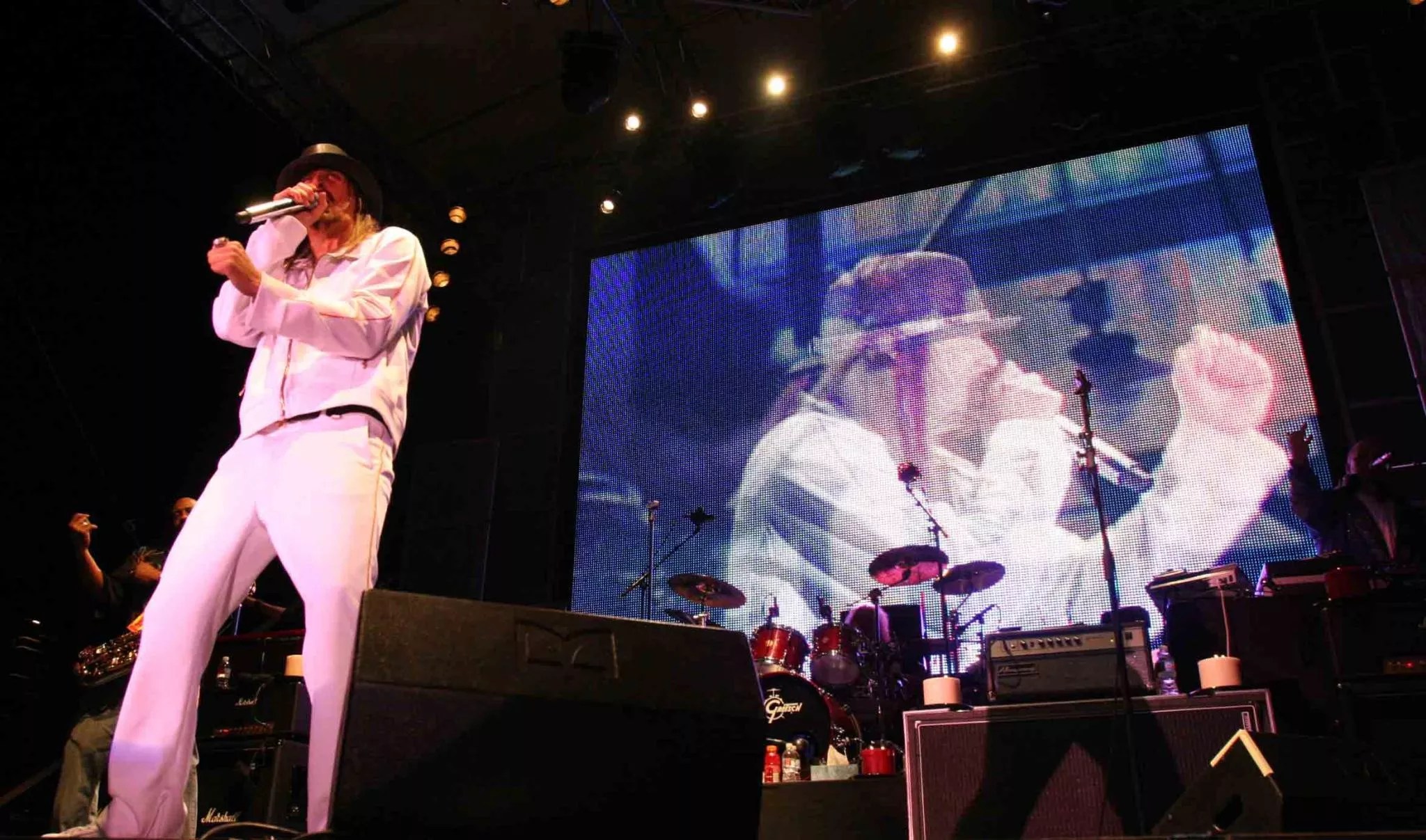
Kid Rock performs outside of Axis-Radius in Scottsdale during Super Bowl week in 2008.
Phoenix New Times archives
Super Gigs
When Super Bowl XLII came to the Valley in 2008, Scottsdale’s bars and clubs hosted numerous star-studded parties during the nights leading up to the big game. Axis-Radius put on several big events, including outdoor concerts by Snoop Dogg, P. Diddy and Kid Rock. (Full disclosure: The events were co-sponsored by Phoenix New Times.)
Corieri: The first Super Bowl in the Valley was in (1996) was a success for us because we had parties at Jetz and Stixx, but it was nothing compared to ’08. The Super Bowl (after) 11 years had grown so big that it was mind-boggling. We were almost kind of dumbfounded by the amount of traffic. Every Super Bowl is huge now, but it was just the sheer amount of visitors that came in ’08, just made (1996) look pale in comparison.
LeVine: Les went all out for the Super Bowl in 2008.
Corieri: We did a block party each night (for Super Bowl week) in ’08. Just the lineup of our talent in the street was phenomenal. We had P. Diddy on Thursday, Friday we had Snoop and then on Saturday, we had Kid Rock. It was a big weekend, to say the least.
DJ MCB: All those Super Bowl events in 2008 were amazing … Kid Rock, P. Diddy, Snoop Dogg. So many good times.
Axis-Radius kept bringing in big names even after the Super Bowl left town.
LeVine: I brought in LMFAO before they became a thing. Every song they did was just epic. Those guys Redfoo and Sky Blu used to come to (Axis-Radius) with their suitcases and perform on the regular and they just put on a show. We were booking them regularly, it seemed like once a month. They’d drive in from California and they were using Axis-Radius to better their sets. I remember they were playing on the Axis side the day they hit it big.
When EDM began its resurgence in popularity in the early 2010s, Axis-Radius started seeing bigger crowds whenever superstar DJs were booked.
LeVine: There were so many big names coming to Axis-Radius. You name ’em. From Kaskade and Calvin Harris to Chris Lake, they all played there.
DJ Soloman: Calvin Harris, when he played there, all 8 feet of him had to duck through to get into the DJ booth. There (was) a little cutout in the bottom of the booth and you have to dip down. And then the speakers are hanging right about your head. But if you’re tall, your head hits the top of it. That was pretty amusing. And then everyone started tweeting about it. Gabriel & Dresden tweeted about it, Fedde Le Grand tweeted about it.
LeVine: Axis-Radius had a lot of dance music in the beginning, then it kind of changed to more of a Top 40 spot and then it eventually went back to strictly dance again. It’s funny how things are cyclical and history repeats itself. (Axis-Radius) tried to keep up with changing times.
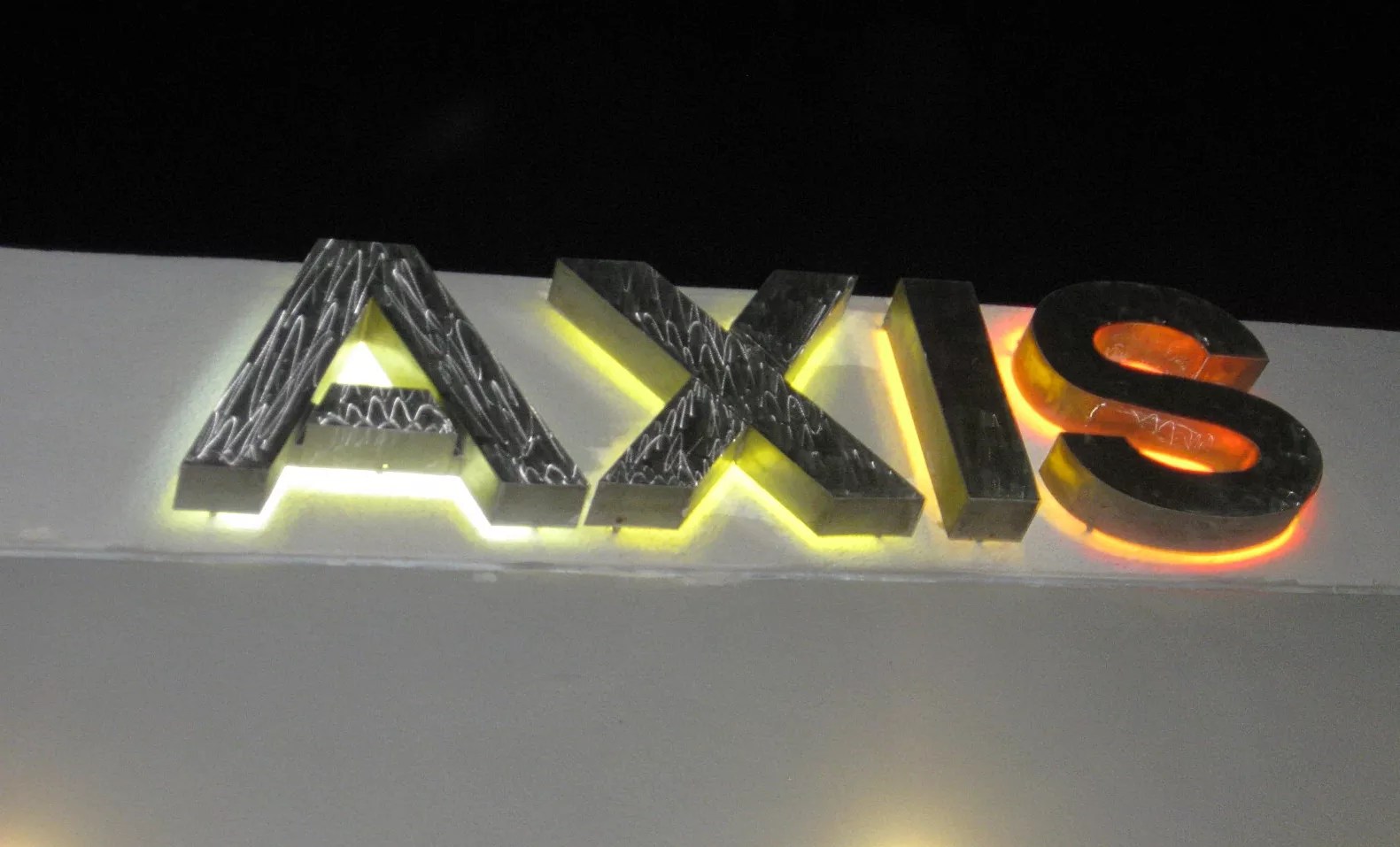
The sign for Axis in Scottsdale in 2009.
Benjamin Leatherman
Scottsdale’s Entertainment District was also changing and evolving in the 2010s. By 2012, Axis-Radius had even more competition from such nearby nightlife joints as El Hefe and the now-defunct Wild Knight. That same year, Evening Entertainment Group-owned spots Myst and Suede were shut down and demolished to make room for Maya Day and Nightclub, a Vegas-style beach club with an outdoor pool and indoor dance club located across the street from Axis-Radius. It opened in April 2013 and immediately attracted big crowds.
LeVine: Maya made a big impact on Scottsdale. Day-clubbing had become more popular. Pool parties had become more popular. We knew that and we saw that. That’s why we all got behind building Scottsdale Beach Club, which was the working title of the place before it became Maya. Maya came out really strong right away.
Meanwhile, Axis-Radius was still hosting superstar DJs like Z-Trip, Steve Aoki, Ferry Corsten and Cedric Gervais, but was showing its age.
LeVine: There were a lot of great DJs who came to Axis-Radius to perform during its last year.
DJ MCB: I opened for Steve Aoki (at Axis-Radius in February 2013). That was pretty wild. That was one of the biggest shows we had there.
Pickster One, local DJ (in 2013): The time I played with Z-Trip at (Axis-Radius) was my highlight. That was amazing seeing him get down in Scottsdale doing what he does best.
Z-Trip: I think the last two times I played (Axis-Radius), I was like, “This place needs a face-lift or else somebody’s going to come into town and fulfill its role.” And I think that’s what happened.
Wegner: Toward the end of its life, Axis-Radius was getting pretty rough around the edges.
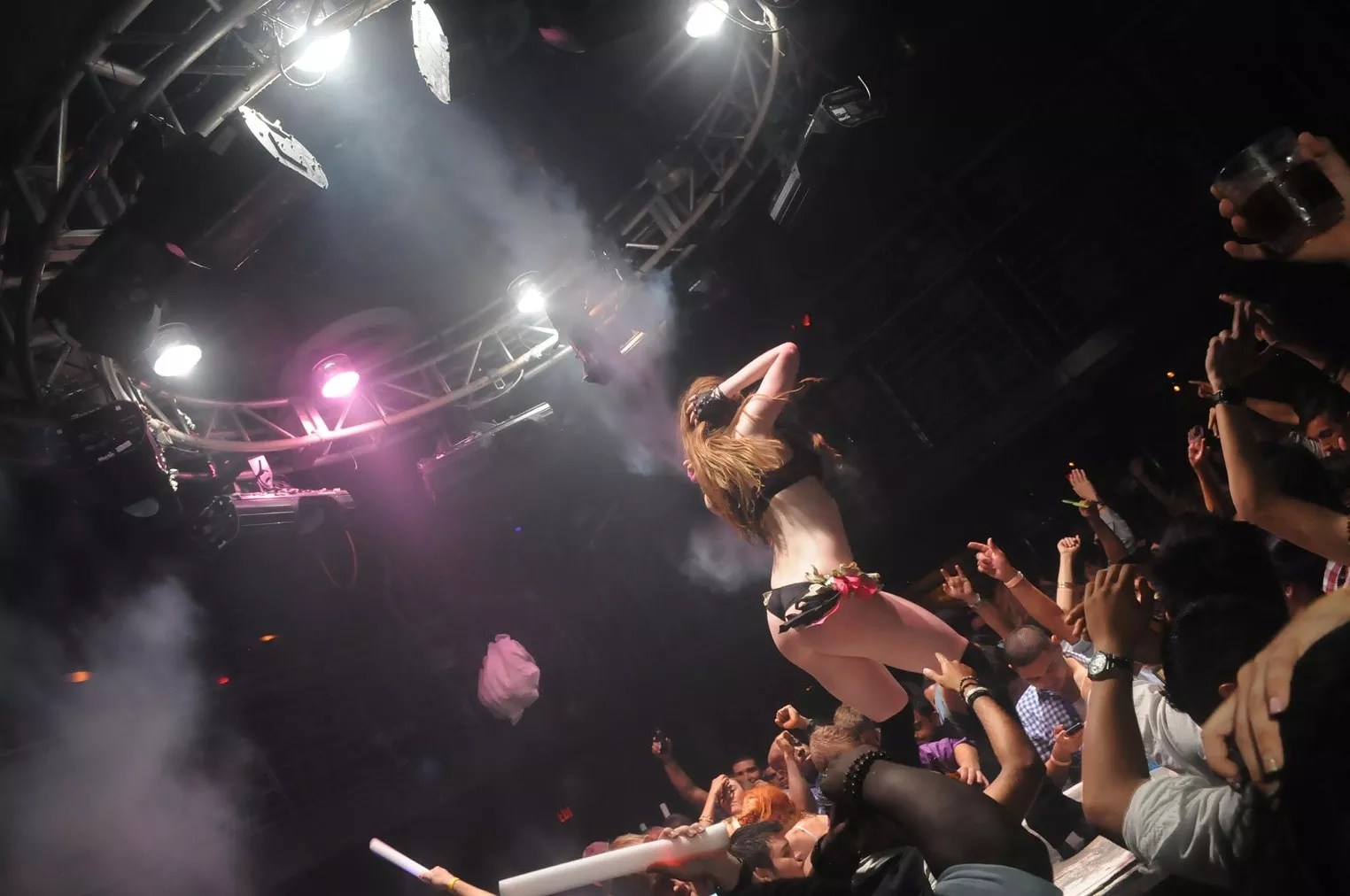
Axis-Radius during its last night in operation on June 29, 2013.
Benjamin Leatherman
Last Call
In June 2013, Evening Entertainment Group announced the closure of Axis-Radius later that month, revealing plans to transform into two distinct concepts: the two-story concert venue Livewire, and Bottled Blonde, an indoor/outdoor beer garden and nightspot. Corieri says it was because the properties needed to become more than just nightclubs.
Corieri: We wanted to go in a different direction with a concept that could be open seven days a week and do business from the afternoon to late night. Since Axis and Radius were pure nightclubs, we were only open four days a week from 10 to 2, and it wasn’t the best use to only operate during those hours. The other reason was we were (booking) touring DJs like Oakenfold and Calvin Harris and because Vegas had gotten into the game of booking (EDM artists) of that caliber, it became more expensive in our market. So we decided to move from being purely nightclubs to venues that are also open for happy hour, food, sporting events, pay-per-view and late night.
LeVine: Axis and Radius ran for a long time and changed when it had to, but it eventually ran its course.
O’Neil (in 2013): You’d be hard-pressed to find a lot of nightclubs that have lasted (as long as Axis-Radius) anywhere in the country.
Axis-Radius exited the nightlife scene following one final dance party on June 29, 2013. More than 1,000 people attended the farewell event and multiple DJs who were Axis-Radius regulars over the years – including LeVine, Wegner and LTJ – performed sets.
LeVine: I remember that final night was pretty epic. I got to DJ and had a great time. It was sad to see the place go, but I also think its time had come.
Wegner: I was invited to DJ at Axis-Radius on closing night. And my friend Ramsey Higgins, who’s a phenomenal DJ, joined me. It was a good night, the dance floor was filled with a lot of people. In some ways, it just seemed like, I don’t know, a regular night. I mean, there wasn’t any crying or anything like that. It was weird.
LeVine: It was definitely the end of an era in Scottsdale.
Corieri: We’re proud of what we’ve accomplished with (Axis-Radius). We could have never thought in our wildest imaginations back in 1996, when we bought the property, that it would turn into what it is today. It’s kind of mind-boggling.
Note: Some quotes have been condensed for brevity and clarity.